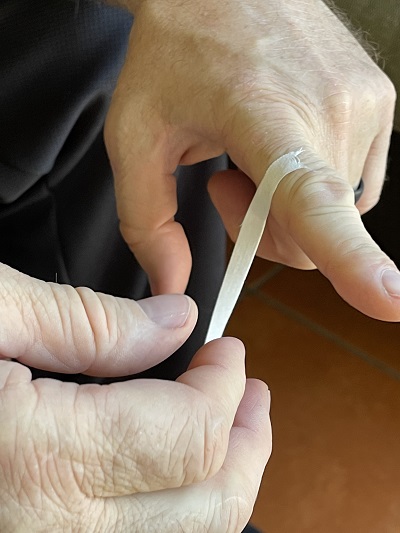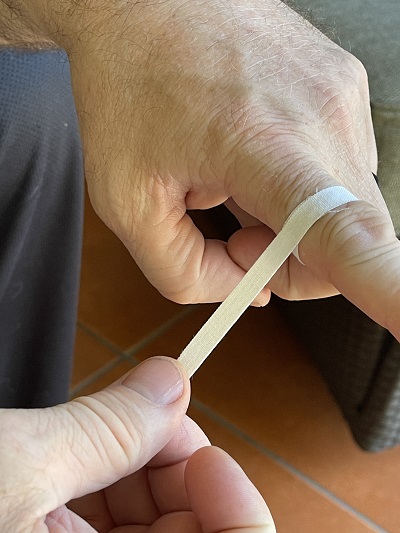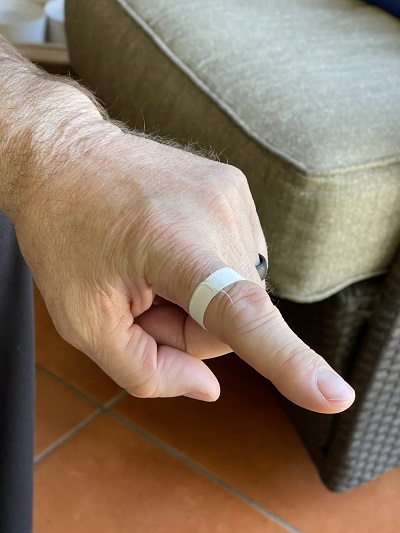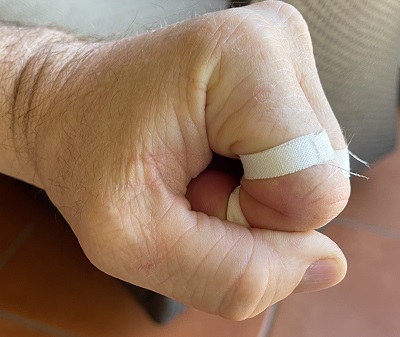Finger Tape
Does taping really help and how do we do it properly?
Every grappler will eventually have to figure out how to deal with hand and finger pain, but some savvy grapplers have adapted their training early, to include finger tape.
First of all, what is finger tape?
It's standard medical bandage tape, sold in a variety of colors and widths. Different brands taut different benefits, but they all serve the same purpose. Wrapping your fingers one or more times, to form a ring of support behind each finger joint, providing additional degrees of finger protection. Sometimes it's used to form added protection against hyperextension. Depending on how it's applied, it can make a good bit of difference in how your hands feel after training. At the most fundamental level, finger tape is a preventative, not a cure, and at times, essential. While it can be a pain to spend five minutes applying finger tape before training and sometimes even longer afterward, to remove it, the benefits outweigh the extra effort spent.
In the simplest and most common application, finger tape is applied just behind the two joints closest to the end of each finger, on the wrist side of each joint. A piece of tape wrapped around the finger in the same direction as every joint, tight enough to be slightly firm but not so tight as to cut circulation, will do the job nicely. When done properly, it won't prevent you from closing your hand into a fist, but it will make the last little bit of closer feel restricted and tight. It provides protection, by binding all of the tissue behind the joint into a single circular ring. The harder you grip with each finger, the more the tissue pushes against the tape, drawing support from the compression. This aids in preventing side loading and helps keep everything where it should be, even under very serious loads.
Finger tape comes in many brands and forms, but simple experimentation will be the best approach to finding the one you like the most.
Factors to consider when choosing your tape.
Does it stay on when you train, even when your hands are soaked in sweat?
Some brands will fail when things get tough and you'll find yourself peeling off bad tape in the middle of training. Only testing can give you this information, but asking others what they use can be helpful.
How hard is it to remove when the time comes?
This is a common reality with most tape. Some tape goes on easy but is very hard to find the end to peel it back off. Color selection can make this better or worse, depending on your choice and the adhesive used can be a curse or blessing.
Does it leave residue or dye behind when it's removed?
If they don't fail during training, the trade-off is most likely a sticky residue left on the fingers afterward and sometimes threads.
When you remove pieces from the roll to apply to your fingers, does it fray and have annoying threads peeling off? Most tape is cut off in larger rolls. In my experience, the cuts are rarely perfectly aligned with the fabric lines. This leads to a slow chasing of the edge, which after a few inches to feet, rewards you with a loss of tracking and threads tearing off the sides. This is usually the point where you end up wasting a few inches of tape to get back in line.
How hard is it to tear off a piece for use? This can be a major pain with some tape. While you want the tape to be strong, one hand is being wrapped and the other is now responsible for tearing off the pieces and applying them to the hand you are wrapping. It can take a lot more time to get the job done if the tape is too strong, but application technique can make this a nonissue.
What thickness is best for my hand?
This is a personal preference, but I and most people I have met who use finger tape, seem to gravitate to 10mm(1 cm - 3/8") tape width.
How much tape length are we talking about on each finger?
You want to wrap each finger at least twice fully around the radius. This varies with hand size, I find 5-6 inches or 127mm - 152mm lengths work for me. Some of your fingers are larger than others, so you will have to find the happy medium or waste some tape to keep things easy.
Should I tear off my tape lengths first and then apply the tape?
Absolutely! This is the fastest way to get the job done but can waste some tape if the lengths are all the same for every finger.
Should I wrap every finger in the same direction?
Removing the tape can be the toughest part. Guessing where the end is, can be a big waste of time already, but not knowing where the end is and which direction it will unwind is even worse. So wrap every piece of tape in the same direction on each hand and it will make your life easier during removal.
When should I be using finger tape?
Most grapplers, especially older grapplers, will find that their hands hurt many days, if not most days. To reduce that annoyance, finger tape should be used regularly as a preventative tool to reduce the risk of injury, especially on Gi days. Learning to properly grip can dramatically reduce the need for finger tape, but some days you just want to throw caution to the wind and ramp up your grip intensity. Those are the days you should have finger tape on for sure.
Will I look like an old person when I wear finger tape?
It's not the old people I see wearing the tape the most. It's the people who train the hardest. I have often been approached by younger people when they see me wearing the tape. The most common comment I get is "Gearing up for a serious battle I see". People will see the tape and form an opinion or ask, but I have taught more young grapplers how to apply tape than older grapplers.
Will it help if my knuckles already look like a 90-year-old with arthritis?
Yes, but it does much more good as a preventative than a recovery tool. I discovered finger tape when my knuckles looked like I had more joints than a human finger should have. The tape helped me recover, but it took much longer than preventing the problem in the first place.
Most medical tapes are white, should I look for colored tape?
As a rule, it seems like most people match their tape with their outfit or Gi. Many manufacturers offer a multitude of colors, so I suggest you select the color you like for the day and keep some variety in your life. The ladies I know who use it, match the fingernail and tape colors to their rash guard colors.
Do people think you're a try-hard if you wear finger tape?
I can't pretend to understand what people think, but I have never been insulted by anyone for wearing finger tape. More often than not, I get people telling me that they should be doing the same.
Should I wrap both joints of every finger or just the ones that hurt?
Interestingly enough, I never wrap the pinky fingers. I have yet to injure one I guess and I must not load those fingers that much during gripping. I do see many people wrap every finger. I can say for sure, that wrapping only the ones that hurt, will almost guarantee that the remaining fingers that did not hurt will end up hurting. The tape itself is a safety system and only as good as the effort you put into using it.
Should I use finger tape for no gi?
I can only say that what you grip can be the deciding factor in how hard you can grip and how much force you can end up applying to your joints. Most grips fail rapidly and in sequence, one finger at a time. Unless you have learned the art of gripping and know when and how to release perfectly, finger tape is likely for you.
Do you have a formula for how you apply the tape to each hand?
I do and I have refined it over the years.
1. Tear off six to eight pieces of tape about 5-6 inches long and stick them carefully on something within reach. Try to only stick about 1/4" section of the tape, to prevent wasting the adhesive on that surface. You want just enough to keep them in a nice orderly line within easy reach. I like to use the side of the leg in the gym or my kitchen table at home, so the tape hangs loose and is easily reached.

2. With the hand not being wrapped, grab one piece of tape.
3. Hold the hand you are taping out in the air flat, within reach of your other hand.
4. Select which finger and joint you are wrapping and begin by sticking the same end of the tape that was stuck to your surface, hanging it downward on the side of the finger closest to your other hand. You are placing it right behind the joint on the finger, on the wrist side. It should not cover the joint. It will fit more like a ring than a band-aid.

5. Firmly but not too tightly, wrap around the finger in a straight line, behind the joint and overlap the tape as perfectly straight as you can. You will get the hang of this and learn quickly if it's too loose or too tight. If it feels wrong, simply unwind it and start again with the same piece. Caution. Do not stick the last very end of the tape to itself, until you are satisfied it is where you want it.


Note: Sometimes straight is not straight to the eye, more straight to the alignment of the joint. The key is the wrapping should line up each loop over the last, as perfectly as possible. Having excess tape hanging off the sides will roll up and expose the sticky side during training.
6. Repeat this process for each finger being taped and start the entire process again for the other hand.

If you follow these steps, it will get easier and faster for you as you get into the practice. By always wrapping each finger in the same direction, removal later becomes much easier. Colored tapes can be much cleaner in appearance during and after training, as opposed to plain white tape. But plain white tape is by far the easiest to locate the ends, for removal later.


One day of using tape will make for one less day of damage, but only marginal recovery comes from a single day of using tape. A regimen of tape use is key to both prevention and recovery. I recommend you buy the tape in bulk and keep an ample supply in your gym bag. Medical tape does not last forever and hates too much heat. So buy enough to last, but keep what you don't need on hand, in a cool dry place for storage and away from sunlight.
Black taped fingers with a black GI look mean. Purple tape with your purple belts looks the role. Use your finger tape to accent your attitude and prevent some finger damage as a bonus.
See you on the mat - Pops
This article was written by 59-year-old - BJJ Black Belt Todd Nelson (aka Pops)